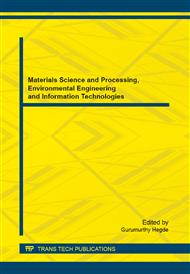[1]
D. C. Look, D. C. Reynolds, J. R. Sizelove, et al. Solid State Commun. Vol. 105 (1998), p.399.
Google Scholar
[2]
Janotti A, Van de Walle Chris G: Journal of Crystal Growth Vol. 287 (2006), p.58–65.
Google Scholar
[3]
J.G. Lu, Y.Z. Zhang, Z. Z. Ye, et al. Mater. Lett. Vol. 57 (2003), p.3311.
Google Scholar
[4]
J. G. Lu, Z. Z. Ye, F. Zhuge, et al. Appl. Phys. Lett. Vol. 85 (2004), p.3134.
Google Scholar
[5]
Y. Nakano, T. Morikawa, T. Ohwaki, and Y. Taga: Appl. Phys. Lett. Vol. 88 (2006), p.172103.
Google Scholar
[6]
Z. G. Yu, P. Wu, and H. Gong: Appl. Phys. Lett. Vol. 88 (2006), p.132114.
Google Scholar
[7]
D. C. Look, G. Renlund, R. H. Burgener II, et al. Appl. Phys. Lett. Vol. 85 ( 2004 ), p.5269.
Google Scholar
[8]
F. X. Xiu, Z. Yang, L. J. Mandalapu, et al. Appl. Phys. Lett. Vol. 87 (2005), p.252102.
Google Scholar
[9]
C. H. Park, S. B. Zhang, and S.H. Wei: Phys. Rev. B Vol. 66(2002), p.073202.
Google Scholar
[10]
O. F. Schirmer: J. Phys. Chem. Solids Vol. 29(1968), p.1407.
Google Scholar
[11]
P. H. Kasai: Phys. Rev. Vol. 130(1963), p.989.
Google Scholar
[12]
D. Block, A. Hervé, and R. T. Cox: Phys. Rev. B Vol. 25(1982), p.6049.
Google Scholar
[13]
B. K. Meyer, H. Alves, D. M. Hofmann, et al. Phys. Status Solidi B Vol. 241 (2004), p.231.
Google Scholar
[14]
E. Tomzig and H. Helbig: J. Lumin. Vol. 14(1976), p.403.
Google Scholar
[15]
M. G. Wardle, J. P. Goss, and P. R. Briddon: Phys. Rev. B Vol. 71(2005), p.155205.
Google Scholar
[16]
J. J. Lander, J. Phys. Chem. Solids 15 (1960), p.324.
Google Scholar
[17]
J. Schneider and O. Schirmer, Z. Naturforsch. B 18a(1963), p.20.
Google Scholar
[18]
D. Zwingel and F. Gärtner, Solid State Commun. 14(1974), p.45.
Google Scholar
[19]
D. Zwingel, J. Lumin. 5(1972), p.385.
Google Scholar
[20]
R. T. Cox, D. Block, A. Herve, R. Picard, and C. Santier, Solid State Commun. 25(1978), p.77.
Google Scholar
[21]
G. Kresse and J. Furthmüller, Comput. Mater. Sci. 6, 15 (1996).
Google Scholar
[22]
H. Su, J. Dai, Y. Pu, et al. Chinese Journal of Semiconductors, 27(7), 1221(2006).
Google Scholar
[23]
X Y Cui, J E Medvedeva, B Delley. Phys. Rev. Lett., 95, 256404(2005).
Google Scholar


